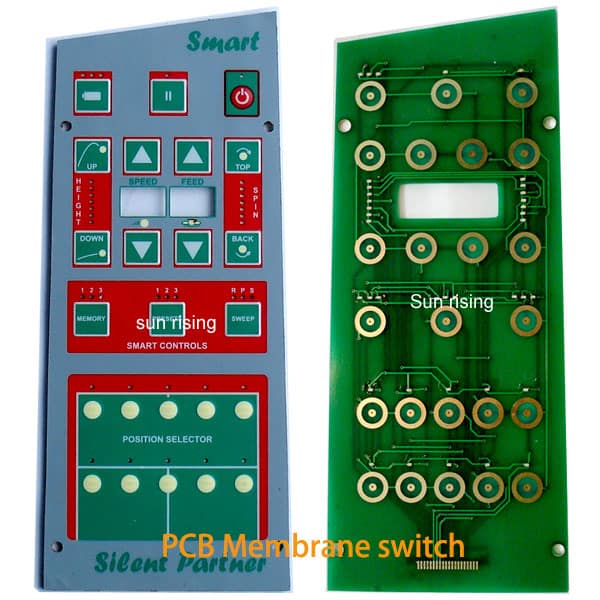Membrane Switches: A Budget-Friendly Solution for Contemporary Control Systems
Membrane Switches: A Budget-Friendly Solution for Contemporary Control Systems
Blog Article
Why Membrane Changes Are Vital for Resilient Control Solution
Membrane buttons play an essential role in making certain the sturdiness and reliability of control systems throughout various sectors. As we check out the complex advantages of membrane layer buttons, it comes to be obvious that their significance transcends simple performance, influencing customer experience and functional effectiveness.
Overview of Membrane Switches
Membrane layer buttons are flexible and trusted parts generally made use of in different digital control systems. The visuals overlay gives both useful and aesthetic design, while the spacer layer guarantees that the switches are activated only when pushed.
Membrane layer buttons are usually preferred in applications calling for a small and lightweight design, making them optimal for handheld devices, clinical tools, and commercial machinery. They can be customized to meet specific customer demands and can integrate various features such as backlighting, responsive comments, and several colors. Membrane layer switches are immune to dust, moisture, and impurities, making them appropriate for environments where longevity is necessary.
Advantages of Durability
In several applications, the toughness of membrane switches over offers significant benefits that enhance their general performance and integrity. These switches are made to stand up to severe environments, making them suitable for use sought after conditions such as high moisture, extreme temperature levels, and exposure to chemicals. Their durable construction aids to stop damages from physical effect, ensuring durable functionality and decreasing the need for regular replacements.
Furthermore, membrane layer switches are immune to wear and tear, which is critical in applications where regular communication occurs. This toughness translates to reduce upkeep costs, as organizations profit from decreased downtime and less solution interruptions. The encapsulated design of membrane switches over shields internal elements from dirt and dampness access, further contributing to their life expectancy (membrane switch).
Another advantage is their ability to maintain constant efficiency with time. With a high tolerance for mechanical stress, these buttons preserve their responsive responses and electric integrity, guaranteeing user complete satisfaction. Inevitably, the durability of membrane changes not just improves operational effectiveness however also fosters confidence in their integrity, making them a recommended option for control systems across different industries.
Applications in Various Industries
Durable control systems using membrane layer buttons discover comprehensive applications across a series of sectors, each gaining from the special characteristics these switches offer. In the clinical market, membrane buttons are essential for tools such as individual monitors and diagnostic tools, where dependability and ease of cleansing are vital. Their resistance to dampness and pollutants ensures they keep performance in sterile settings.
The automobile industry leverages membrane layer switches for control panel controls and infotainment systems, where they provide streamlined, low-profile user interfaces that improve customer experience. These switches are additionally created to withstand rough conditions, consisting of exposure to severe temperatures and resonances.
In industrial setups, membrane layer switches are commonly utilized in equipment control panels, supplying tactile responses and sturdiness necessary for high-usage applications. Their capability to stand up to chemicals makes them suitable for making environments where spills and pollutants are frequent.

Consumer electronic devices, such as kitchen home appliances and remotes, also utilize membrane buttons for their versatility and cost-effectiveness. In general, the versatility and durable nature of membrane layer switches make them vital throughout from this source different fields, ensuring effective procedure and long life in control systems.
Design and Aesthetic Allure
While performance is paramount, the style and visual appeal of control systems equipped with membrane layer buttons play a vital role in user engagement and general experience (membrane switch). The aesthetic layout of these buttons can significantly influence individual understanding and interaction. A properly more helpful hints designed membrane layer button boosts the good looks of the device, making it more appealing to users and fostering a connection between the customer and the item
Membrane layer switches over supply a good deal of flexibility in design, permitting suppliers to tailor graphics, shades, and structures to line up with brand identity and product appearances. The usage of lively colors and distinctive patterns can draw attention, while tactile responses can enhance the individual's interaction with the device. Additionally, the capacity to incorporate LED indicators and backlighting right into the membrane layer switch layout gives both useful and aesthetic benefits, boosting presence and use in different environments.

Enhancing Customer Experience

In addition, membrane layer buttons can be customized to integrate visual user interfaces, boosting use by offering information in a clear and intuitive manner (membrane switch). This customization can include icons, labels, and color coding that guide users through complex functionalities with ease. Additionally, their versatility enables integration in various environments, ensuring regular efficiency whether in commercial equipment or consumer electronics
The resilience of membrane buttons additionally plays an essential duty in individual experience. By standing up to severe conditions and extended usage, these buttons decrease the likelihood of system failings, hence promoting reliability and user self-confidence. Eventually, the tactical use of membrane layer changes not only boosts performance but additionally substantially enhances user communication with control systems, making them an important component in modern-day style.
Conclusion

Report this page